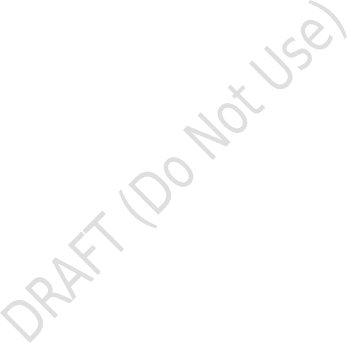APA-MARAD Manufacturer Interview Guide MA-2003
AAPA-MARAD Manufacturing Interview Guide MA-2003 5.25.2023.docx
Building American Production Capacity for Electric Port Equipment and other Port Infrastructure Items
APA-MARAD Manufacturer Interview Guide MA-2003
OMB: 2133-0556
O MB
2133-XXXX
MB
2133-XXXX
Expiration
Date: XX/XX/XXXX
AAPA-MARAD
Survey
Draft Manufacturer Interview Guide
Paperwork
Reduction Act Notice
This
request is in accordance with the Paperwork Reduction Act of 1995.
The information you provide will be used to identify the demand for
electric powered port equipment and items.
The
estimated average burden associated with this collection of
information is approximately 2 hours per response, including the
time for reviewing instructions, completing, and reviewing the
collection of information. All responses to this collection of
information are voluntary. Comments regarding this burden estimate
or any other aspect of this collection of information, including
suggestions for reducing this burden to: Information Collection
Clearance Officer, Maritime Administration, MAR-390, 1200 New Jersey
Avenue, SE, Washington, DC 20590.
An
agency may not conduct or sponsor, and a person is not required to
respond to a collection of information unless it displays a current
valid Office of Management and Budget control number.

Introduction
Purpose: The Infrastructure Investment and Jobs Act and the Inflation Reduction Act make historic levels of infrastructure funding available to ports. However, the funding has domestic sourcing requirements, and much of the cargo handling equipment and other port items that ports would like to purchase with grant funds is not manufactured in the U.S. The American Association of Port Authorities (AAPA), with support from the U.S. Maritime Administration (MARAD), is seeking to develop a nationwide picture of port cargo handling equipment demand.
Confidentiality: Your responses will be kept strictly confidential. Your responses will be anonymized and aggregated into industry results presented in reports or presentations.
Motivation: AAPA and MARAD recently surveyed ports and marine terminal operators and determined that there is a multi-billion-dollar market for cargo handling equipment over the next 5-10 years. We learned that ports and terminals expect to use government funds for a large part of those purchases. A large portion of those funds are tied to U.S.-produced content under “Buy America” and “Buy American” requirements.
Qualification
Are you currently serving the U.S. port and terminal equipment market? Are any of your products built or assembled in the U.S.?
What is the current share of U.S. content (e.g., components) in your products?
Does your company have any plans to increase U.S. content, or interest in doing so, to qualify for government funding?
If yes, continue to Question 4.
If no: Thank you. That is the end of our questions.
Company and Products
Please give us a brief overview of the cargo-handling equipment and other port/terminal products you produce (or sell/distribute).
Which cargo handling equipment types are offered in automated, electric, alternative fuel, or hybrid versions?
Do you have additional automated, electric, alternative fuel, or hybrid versions under development? Anticipated?
For each major type, can you give us some idea of annual production capacity?
Can you give us some idea of current lead times for new orders?
Figure 1 - For Interviewer Convenience in Noting Responses
-
Type
Electric?
Alt Fuel?
Hybrid?
Annual Capacity (units)
Lead Time
Note
STS Crane
ASC
RMG
RTG
Mobile Crane
Straddle Carrier
Reach Stacker
Side Loader
Empty Handler
Forklift
Yard Tractor
AGV
Yard Chassis
Bollards
Fenders
Other
Equipment Production
Where are these products manufactured? Assembled?
Does this involve partner firms?
Do you anticipate any changes in manufacturing or assembly locations?
Is any U.S. content added during assembly or installation?
Do you have any plans for expanding production capacity? Where?
How do you transport your products to U.S. customers?
Government Promotion
To the best of your knowledge, have U.S. ports or terminal operators used government funds to purchase your equipment? Can you give us an example?
Have your products previously qualified for Buy American or Buy America programs?
(If yes) How did you qualify? (If no) If you wanted to qualify, what would you need to change?
Overview and Close
How do you see the future market for port and terminal handling equipment developing?
How do you think electrification or alternative fuels will affect that market?
What barriers do you face (market, operations, finance, etc.) in serving the U.S. port and terminal market?
What else should we know about the U.S. market for port and terminal equipment?
Who else should we talk to?
Privacy Act Statement
The following information is provided pursuant to Section 3 of the Privacy Act of 1974 (5 U.S.C. § 55a(b)93):
Authority: This survey is being conducted through a cooperative agreement between the Maritime Administration (MARAD) and the American Association of Port Authorities (AAPA).
Purpose: The proposed collection (Building American Production Capacity for Electric Port Equipment and Other Port Infrastructure Items) will be used to identify the demand for electrically powered port equipment and other port infrastructure items supported by a pooled procurement.
Routine Uses: Responses will be kept strictly confidential by AAPA and its contractor. Responses will be anonymized and aggregated into industry results presented in reports or presentations.
Disclosure: Disclosure of this information is voluntary.
Effects of Not Supplying the Requested Information: Failure to provide the requested information will limit the accuracy of the reported results and the potential for a pooled procurement.
MA-2003 Page
| File Type | application/vnd.openxmlformats-officedocument.wordprocessingml.document |
| File Title | Heading 1 |
| Author | Dan Smith |
| File Modified | 0000-00-00 |
| File Created | 2023-09-04 |
© 2025 OMB.report | Privacy Policy